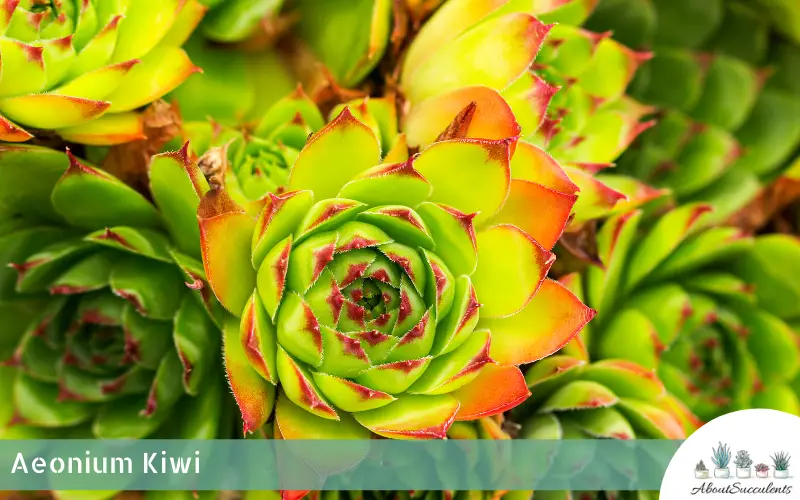
Aeonium kiwi is an eye-catching succulent with its spoon-shaped leaves forming a rosette that has deep, vibrant shades of yellow and green. When given frequent exposure to the sun, the tips of its leaves will develop brilliant red colors.
The show-stopping succulent also blooms yellow flowers in the summer. As a monocarp, Aeonium kiwi it will die after it produces flowers.
Aeonium kiwi is called by 3 other names: Decorum kiwi, Dream Color, and Tricolor.
The name “Aeonium kiwi” is actually the scientific name for Kiwi Aeonium and is sometimes mistaken as a hybrid of the Aeonium haworthii which translated means “tricolor”.
Decorum kiwi can grow to a height of 3-feet (90cm) with a width of 3-feet (90cm) and comes from the Crassulaceae family. Its origin is a mystery but the Aeonium kiwi is thought of to be native to the Canary Islands.
General Information:
Also known as: Decorum kiwi, Dream color, Tricolor
Plant Family: Crassulaceae
Origin: Canary Islands
Height: 3-feet (90cm)
Exposure: Full to partial sunlight up to 6 hours per day
Water Needs: Watering every 7 to 10 days; more watering in the growing season which is winter to spring, less watering in the summer season.
Soil Type: Cactus soil or soil mix made of potting soil with equal parts of sand, gravel, and perlite.
Soil pH: Acidic (6.1 to 6.5 pH)
Tolerance: Drought
How To Grow And Care For Aeonium Kiwi
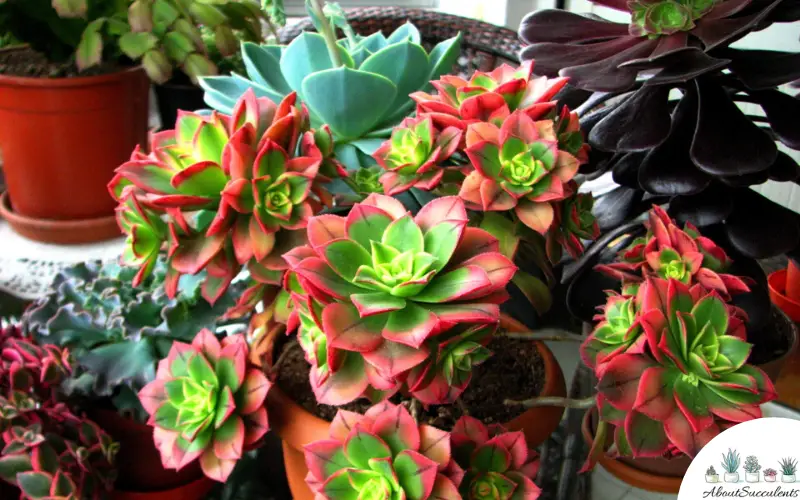
Aeonium kiwi is a favorite of both experienced and novice succulent growers alike not because of the plant’s captivating beauty but also because this variety grows quickly.
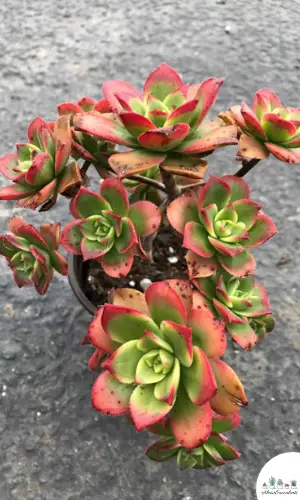
Its distinct colors and appearance will require specific care and conditions to ensure proper growth.
1. Sunlight
Aeonium kiwi loves the sun and achieves its true beauty with regular exposure. If you want to have Aeonium kiwi as a garden plant, put it in an area where it will receive 6 hours of morning sunlight every day.
Decorum kiwi is not a cold-hardy plant and will not thrive in temperatures that go below 30° F (-1.1° C). If you live in a region that experiences this kind of temperature drop, it is advised to move the succulent indoors. Place it near a window that receives partial to full sunlight.
2. Watering
Aeonium kiwi is peculiar in that it is more averse to hot and dry climates and requires more water than other succulents.
Succulent plants are sensitive to overwatering as they can develop root rot. Aeonium kiwi is more resistant to the effects of overwatering. If most succulent varieties are given water every 10 days, Aeonium kiwi may need to be watered every 7 days.
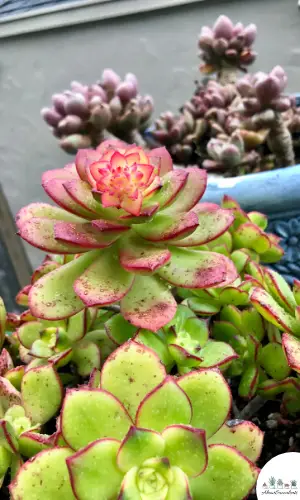
To be safe, follow the guideline for the soak-and-dry method. Insert your finger 2 inches into the soil and assess its moisture level. If the soil is dry, give the plant water.
Decorum kiwi needs more water from winter to spring which is its active growing period. In the summer, when it is dormant, water the plant if you observe that its leaves are showing signs of wrinkling.
3. Pot and Soil
Choose a pot for Aeonium kiwi that has excellent drainage and enough room for well-draining soil.
It is recommended to re-pot Aeonium every few years to maintain good health. Re-potting is best done before its period of dormancy ends which is the summertime.
With this kind of succulent, commercially available potting soil may not be enough to assure its growth and health. You should add equal parts of sand, gravel, and perlite to improve its moisture retention and drainage properties.
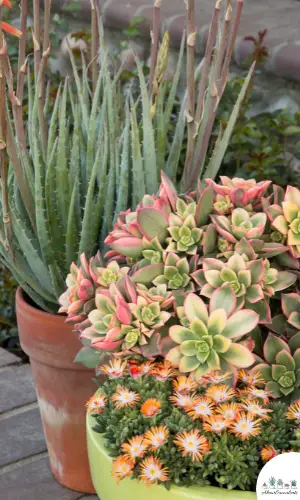
Aeonium kiwi does not require fertilizer but it will not do any harm to give it once a month during the growing season. Make sure the fertilizer is diluted to ¼ of its original strength. Do not give the Aeonium kiwi succulent fertilizer during its dormancy period.
How To Propagate Aeonium Kiwi
Aeonium kiwi is very easy to propagate. For better results, propagate during the winter months when Aeonium kiwi propagates rapidly.
There are 3 methods you can use to expand your collection of this tantalizingly beautiful succulent: Cuttings, offsets, and seeds.
1. Cuttings
Step 1 – Use a sterilized and sharpened knife to remove a stem from the main plant.
Step 2 – Leave the stem in a warm and dry area and allow it to develop calluses. The process will take around 3 to 5 days.
Step 3 – Plant the callused stem in well-draining soil.
Step 4 – If the soil is dry to the touch, give it some water.
2. Offsets
Step 1 – You will find many offsets growing at the base of the plant.
Step 2 – Gently remove the offsets.
Step 3 – Give the offsets 1 to 2 days to grow calluses in a dry and shaded area.
Step 4 – Place the offsets in a pot with well-draining soil.
3. Seeds
Step 1 – Make sure you are growing seeds at a warm temperature or that you have a Grow Light and a Seed Warmer.
Step 2 – Plant seeds in well-draining soil.
Step 3 – Water the soil whenever it feels dry to the touch. Germination could take several weeks.
Frequently Asked Questions
Is Aeonium Kiwi Toxic for Cats and Dogs?
Aeonium kiwi does not appear in the list of toxic plants for cats and dogs on the website of the American Society for the Prevention of Cruelty to Animals (ASPCA) and is considered generally safe for animals and humans.
Why is my Aeonium Kiwi Succulent Dying?
If you suspect your Aeonium kiwi is not in good health or could be dying, there are 3 possible causes: Overwatering, lack of sun exposure, and pest infestation.
1. Overwatering
While Decorum kiwi needs more water than the typical succulent plant, it is still susceptible to root rot.
Immersing the roots in water for an extended period or giving Aeonium kiwi more water than is necessary can lead to root rot.
Discoloration is a sign of root rot. Parts of the plant will change to a brownish or blackish color. Once you see these colors form, use a sterilized knife to cut off the section before it infects the entire plant.
Remove Aeonium kiwi from the soil and allow it to dry completely. Replant Aeonium kiwi in a new pot that is filled with fresh, well-draining soil.
2. Lack of Sun Exposure
Etiolation is the condition where the stems of Aeonium kiwi are stretched out and are caused by a lack of sun exposure.
Make sure to give the Aeonium kiwi succulent enough sun exposure on a daily basis. This plant thrives with full to partial sun exposure.
Do not overexpose as its leaves are prone to sunburn.
3. Pest Infestation
Mealybugs and aphids are attracted to Aeonium kiwi. These pests love to drink the sap of the succulent.
You can remove mealybugs from the plant by wiping off the white, cotton-like substances the pest produces on the leaves.
Aphids can be eliminated with the use of insecticide soap, orange spray guard, and neem oil.
Does Aeonium Kiwi Produce Flowers?
Yes, Aeonium kiwi blooms beautiful flowers in the summertime. As a monocarp, the succulent will die once it produces flowers.
The good thing is that Decorum kiwi propagates very fast. With the use of its cuttings, offsets – which are plentiful – or seeds, you can have Aeonium kiwi growing in no time at all.
Last Updated on June 10, 2022 by Sofia Lara